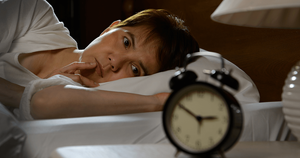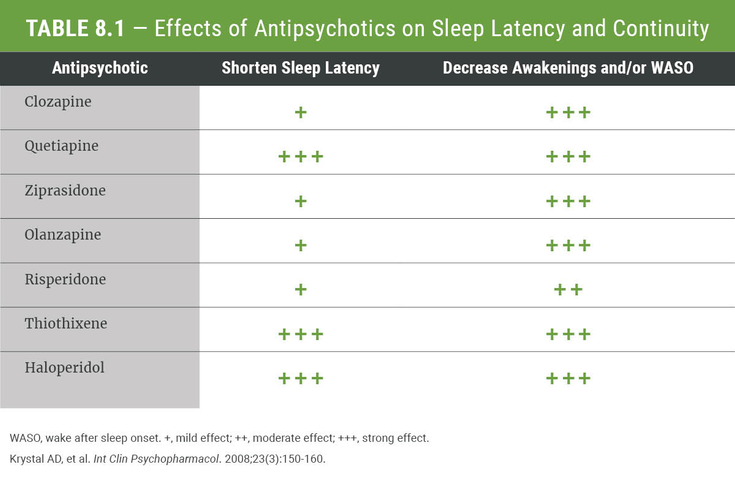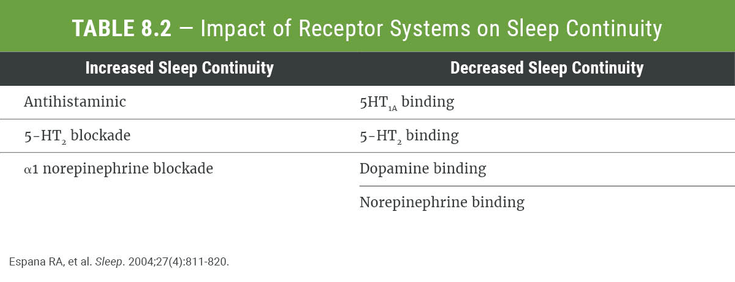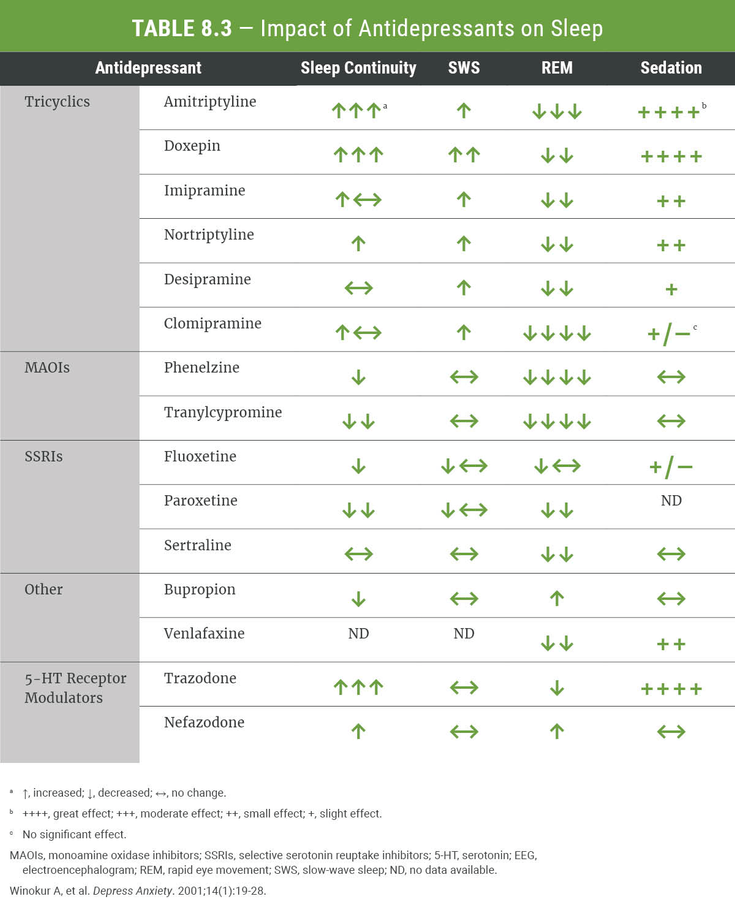Management of Comorbid Conditions
Introduction
Insomnia is much more likely to exist in the context of other medical and psychiatric conditions than to exist on its own. However, the majority of studies into efficacy and safety have been performed without consideration of comorbid conditions. A systematic evaluation is the first step in the identification of conditions that are comorbid with insomnia.
As mentioned in the previous section, the evaluation of insomnia should uncover any comorbid conditions; treatment should be directed at those conditions first whenever possible. Once associated disorders have been identified, existing management modalities should be optimized in an effort to achieve resolution of the insomnia complaint. In general, effective management of comorbid psychiatric disorders results in a decrease in insomnia complaints. However, for many who have insomnia, this is not always the case. It is also often helpful to manage insomnia directly and concurrently while managing the comorbid condition.…
To continue reading
Log in or register to continue reading. It's free!
OR
By signing up to create an account, I accept Healio's Terms of Use and Privacy Policy.
Introduction
Insomnia is much more likely to exist in the context of other medical and psychiatric conditions than to exist on its own. However, the majority of studies into efficacy and safety have been performed without consideration of comorbid conditions. A systematic evaluation is the first step in the identification of conditions that are comorbid with insomnia.
As mentioned in the previous section, the evaluation of insomnia should uncover any comorbid conditions; treatment should be directed at those conditions first whenever possible. Once associated disorders have been identified, existing management modalities should be optimized in an effort to achieve resolution of the insomnia complaint. In general, effective management of comorbid psychiatric disorders results in a decrease in insomnia complaints. However, for many who have insomnia, this is not always the case. It is also often helpful to manage insomnia directly and concurrently while managing the comorbid condition. Since the identification and/or successful treatment of the cause or comorbidity may take time, the patient’s sleep problems may continue to cause significant distress and possibly daytime dysfunction. Alleviating difficulty in sleeping will at least relieve an uncomfortable symptom, and it may also improve quality of life. And quite significantly, some studies also suggest improvement of the comorbid medical/psychiatric condition as well.
Insomnia and Anxiety/Mood Disorders
Anxiety Disorders
General anxiety disorder (GAD)–specific cognitive behavioral therapy (CBT) can improve insomnia when used for the treatment of GAD. Imagery rehearsal with dream rescripting for the nightmares of patients with PTSD can improve sleep continuity, presumably as a consequence of diminished nightmares. Nonpharmacologic treatments primarily treating mood disorders can also diminish sleep disturbances, yet their effects may be more modest compared with antidepressants. Psychotropic medications used to treat anxiety on subjective and objective measures of sleep continuity are listed in Table 8-1. Currently available evidence suggests that “co-modal” interventions – i.e., targeting both insomnia and the comorbid psychiatric disorder, including anxiety – is more beneficial than treating only the psychiatric comorbidity.
In one study, patients with insomnia and comorbid GAD received open-label escitalopram 10 mg/d and were randomized to receive either nightly concomitant zolpidem ER 12.5 mg or placebo. TST was greater in the zolpidem ER/escitalopram group than in the placebo/escitalopram group at each time point (Figure 8-1). In addition, improvements were noted in sleep latency, WASO, number of awakenings and quality of sleep throughout the treatment period with zolpidem ER/escitalopram vs placebo/escitalopram. Zolpidem ER is not approved for the treatment of GAD.
The coadministration of eszopiclone and escitalopram was also evaluated in a study of patients with comorbid insomnia and GAD. Patients received 10-mg escitalopram for 10 weeks and were randomized to also receive either 3-mg eszopiclone or placebo nightly for 8 weeks. The addition of eszopiclone to patients receiving escitalopram resulted in improvements in sleep latency, TST and WASO compared with escitalopram and placebo (Figure 8-2). Patients taking eszopiclone and escitalopram also exhibited improvements in total Hamilton Anxiety Scale (HAM-A) scores at each week and at weeks 4 through 10 with the insomnia item removed. After eszopiclone discontinuation, there was no evidence of rebound insomnia and, while treatment differences in anxiety measures were maintained, differences in sleep outcomes were not. Eszopiclone is not approved for the treatment of GAD.


Mood Disorders
Patients being treated for depressive and anxiety disorders often are prescribed antidepressants, which may be associated with either sleep-promoting or sleep-disturbing effects. Effects of antidepressants on sleep can be partially attributed to their receptor profiles. The positive effects on sleep continuity and latency appear to be largely mediated by the inhibition of histaminic, α1 adrenergic and 5-HT2 receptors, whereas enhanced activity at these receptors confers a greater degree of sleep continuity disturbance (Table 8-2). Although effective management of psychiatric disorders generally leads to a reduction of sleep-related complaints in parallel with other disease-specific symptoms, the medications involved in this treatment may also produce additional sleep-related effects due to their direct effects on the processes governing sleep and wakefulness. There is also greater potential for the production of undesirable daytime sedation.
Pharmacologic therapies directed at comorbid psychiatric disorders can diminish insomnia complaints, yet 25% to 45% of those treated with pharmacologic agents for mood or anxiety disorders continue to complain of insomnia following remission. These persistent sleep abnormalities are common and their causes varied. In some cases, this may be indicative of lingering depression. Certain sleep electroencephalogram (EEG) alterations predict the future onset of depression and persist following its remission. However, other studies have suggested that they may be state specific, raising the possibility that the persistence of sleep abnormalities represents incomplete treatment despite the achievement of conventionally established remission criteria.
In addition, the persistence of subjective complaints such as insomnia following the achievement of remission can represent the effects of comorbid medical and other psychiatric disorders. Iatrogenic causes related to the medications used to treat the comorbid psychiatric disturbance must also be considered. Residual depressive symptoms are associated with higher rates and earlier occurrence of relapse and recurrence compared with asymptomatic recovery in major depression. The association between the persistence of insomnia and depression recurrence is independent of other depressive symptoms, chronic medical disease and antidepressant medication use.
Effects on sleep parameters differ according to the class of antidepressant used. Prior to instituting treatment with an antidepressant, it would be beneficial to have available a profile of the various antidepressants regarding their relative effects on sleep. Based on individual, noncomparative studies, antidepressants that have sedating effects include several tricyclic antidepressants (TCAs) (amitriptyline, imipramine, doxepin and trimipramine), trazodone, nefazodone and mirtazapine. Those that may be more disruptive of sleep include nonsedating TCAs (clomipramine, desipramine and protriptyline), monoamine oxidase inhibitors, selective serotonin reuptake inhibitors (SSRIs), serotonin–norepinephrine reuptake inhibitors (SNRIs) and bupropion. SSRI antidepressants have been the preferred medications in treating anxiety and depressive disorders but are more likely to have neutral or negative effects on sleep. The effects of psychotropic medications used to treat mood disorders on subjective and objective measures of sleep continuity are listed in Table 8-3.
In patients with insomnia and MDD, three general prescription strategies apply:
- Monotherapy: treatment of the MDD and coexisting insomnia with an antidepressant alone
- Polytherapy: antidepressant for MDD and medication indicated for insomnia
- Nonpharmacologic techniques: Although these methods have not been extensively examined in the context of MDD with coexisting insomnia, there is ample evidence that they are highly effective for the treatment of primary insomnia and MDD. Nonpharmacologic techniques for the treatment of primary insomnia are reviewed in Behavior Strategies.
The effects of antidepressants on polysomnographic sleep patterns have been extensively reviewed. However, these effects may not yet have direct clinical relevance for the primary care physician and are of greater research interest than clinical interest. Regarding their subjective effects, which may be of greater clinical relevance, studies indicate that antidepressants, when administered at doses appropriate for the treatment of depression (as opposed to low-dose strategies) are effective in decreasing sleep complaints in depressed patients when they are considered as a group.
However, some patients may also experience either no improvement or even a worsening of insomnia complaints. Studies reveal that nearly half of patients meeting criteria for a full response for depression have a persistent difficulty with sleep (Figure 8-3). The reasons for these negative effects are difficult to discern in any given case. However, they may be due to:
- Poor response of the underlying depression to that particular antidepressant; the persistent insomnia can represent evidence of a persistent depression, in which case additional time on antidepressant medication, increasing the dosage, augmenting it with another antidepressant, or switching the antidepressant agent should be considered.
- The Iatrogenic effect of the antidepressant medication, i.e., disruptive effect on sleep, in which case additional time on antidepressant medication may impart some degree of tolerance to these effects. Additional measures include decreasing the dosage of the antidepressant medication, yet this may be a poor strategy since it risks the possibility of diminishing its effect against depression. Another option would be to utilize the polytherapy options.
Advantages to prescribing separate medications for the insomnia and psychiatric disorders include the possibility of drawing from a wider range of medications and the ability to change medication selections and dosages independently according to the clinical circumstances. There is some evidence that the addition of low doses of sedating antidepressants to the already existing antidepressant may have some benefit. The most widely utilized agent for this purpose is trazodone, although it is not approved by the FDA for this use. Based on data from a single, moderate-quality trial of trazodone 50 mg which showed a modest benefit but significantly increased probability of adverse events (notably headache and somnolence), the 2017 AASM guidelines suggest that trazodone not be used for the treatment of insomnia. Authors have also cautioned regarding the potential for the development of a “serotonin syndrome” when this agent is combined with antidepressants. Additionally, studies of this use are limited due to small sample sizes and lack of placebo-control conditions. Other agents that have received similar attention in this area are low doses of amitriptyline and doxepin.
Continuing the discussion of the polytherapy option, hypnotic agents have also been examined in the context of patients with MDD on antidepressants. Co-administration of hypnotics (ie, zolpidem, eszopiclone) in SSRI-treated (fluoxetine, sertraline, or paroxetine) patients with MDD and persistent insomnia in multiple studies resulted in improved subjective sleep variables, such as sleep latency, TST and WASO. Additionally, improvements in depression (HAM-D) scores were often observed (Figure 8-4). To isolate the effect of insomnia treatment on depression alone, one study removed the HAM-D insomnia items from the analysis. The differences were still significant at week 8 even without the insomnia items (Figure 8-5). As expected, HAM-D differences were greater in patients with more severe depression. At week 8, significantly more eszopiclone patients were responders (74% vs 61%, P <0.009) and remitters (54% vs 41%, P <0.02). These results suggest that insomnia itself may be etiologically related to depression in a bidirectional fashion. It should be noted that hypnotics are not FDA indicated for the management of depression. These results also suggest that co-management of insomnia in the context of MDD treatment may be important for the optimization of the management of depression itself, although this practice has not been well studied. Once remission is achieved, hypnotic medication can be withdrawn.



Insomnia and Neurologic Conditions
Movement Disorders
RLS is a sleep disorder associated with motor restlessness and an irresistible urge to move the extremities that worsens as the day progresses and results in insomnia. Treatments include various behavioral measures, iron supplementation, dopamine agonists, benzodiazepines, opioids and antiepileptic compounds. Only gabapentin enacarbil and the dopamine agonists (pramipexole, ropinirole, rotigotine) are indicated by the FDA for the treatment of RLS. In general, these studies reveal a reduction in sleep-related complaints, both at sleep onset and following sleep onset.
Insomnia and Sleep-Related Breathing Disorders
Chronic Obstructive Pulmonary Disease
Insomnia is thought to be related to a variety of disease-specific factors, such as excessive mucus production and cough and the increased work of breathing associated with airflow limitation and hypoxemia and/or hypercapnia during sleep, resulting in an increase in ventilation and respiratory effort, which in turn leads to sleep-related arousals and awakenings.
Few studies investigated the effects of disease-specific treatments and their effects on sleep. The β2 agonist albuterol does not affect sleep quality adversely in patients with asthma and COPD and the anticholinergic medication ipratropium resulted in improved subjective sleep quality and an increase in REM sleep time in patients with moderate to severe COPD. The effects of oxygen supplementation on sleep in COPD have been variable, with some studies revealing improvement and others revealing no change. The limited data that are available regarding disease-specific treatments for comorbid insomnia disorders suggest that treatment of the comorbid disorder can produce a diminution of insomnia severity and caution against ignoring the comorbid disorder in favor of treating insomnia directly.
Obstructive Sleep Apnea Syndrome
The effective management of various sleep disorders appears to be helpful in diminishing insomnia complaints and improving sleep latency and continuity. Approximately 39% to 55% of OSAS patients report insomnia symptoms (often the only presenting sleep-related symptom), primarily a difficulty in staying asleep. Established treatments for OSAS include lifestyle changes such as the avoidance of CNS depressants, weight loss, body positioning devices, dental appliances, upper airway surgery and positive airway devices that are utilized during sleep such as CPAP (the most common first step). A few studies have documented improvement in insomnia severity following the treatment of sleep disordered breathing in patients with insomnia and comorbid OSAS. Treatments that have been examined in this regard include nasal-dilator strips, surgery, and a combination of treatments, including CPAP, oral appliances, or bilateral turbinectomy. In the latter study, the addition of CBT provided additional benefit for insomnia symptoms. It should be noted, however, that insomnia may also complicate the course of treatment with CPAP in certain OSAS patients and possibly diminish compliance with CPAP, in which case direct management of insomnia may be beneficial; this practice will be discussed in the next section. Management strategies that address both OSAS and insomnia, eg, by incorporating CBT-I in addition to OSAS-directed therapy, produce the best outcomes.
Insomnia and Circadian Rhythm Disorder
Management of the sleep component of circadian rhythm disorders includes behavioral practices such as sleep schedule adjustment and proper sleep hygiene practices, timed bright light administration, melatonin and hypnotic agents. Studies have shown that correction of the underlying sleep phase misalignment can result in improved sleep continuity, diminished sleep latency, lessening of insomnia severity and lessening of wake-time sleepiness. Although melatonin has not been widely accepted as a consistently effective treatment for undifferentiated insomnia complaints, it has been shown to be effective in advancing the sleep-wake rhythm and endogenous melatonin rhythm in delayed sleep phase disorder, leading to a decrease in sleep latency in that disorder. It has also been shown to hold promise in the treatment of shift work disorder, where results have been inconsistent, with some studies revealing a shift in circadian phase in parallel with improved sleep quality and duration.
Insomnia and Heart Failure
Patients with heart failure must often take multiple medications that may affect sleep patterns, including beta-blockers, loop diuretics, angiotensin-converting enzyme (ACE) inhibitors, angiotensin receptor blockers (ARBs) and aldosterone receptor blockers. In patients with chronic heart failure (CHF), worsening symptoms are often associated with increased prevalence of insomnia. In turn, insomnia may worsen symptoms of heart failure such as fatigue and low energy levels. Because of the complex relationship that exists between CHF and insomnia, it is uncertain whether effective treatment in chronic primary insomnia will be effective in treatment of comorbid insomnia associated with heart failure. However, there is little evidence that typical medications used to treat heart failure adversely affect sleep in these patients. Optimizing medical therapy for heart failure should be the first step in treating patients with comorbid insomnia related to heart failure.
Insomnia and Gastrointestinal Disorders
There is a significant association between disturbed sleep and GERD, and may be due to diminished esophageal acid clearance during sleep, which is thought to be responsible for the high rate of sleep-related reflux symptoms in GERD sufferers. Treatment of GERD with proton pump inhibitor medications reduces esophageal acid exposure and restores sleep continuity by diminishing their associated arousals and awakenings. Conversely, symptomatic treatment of insomnia with hypnotic agents, although it results in an improvement of sleep quality, can also lead to an increase in esophageal acid exposure by reducing the protective arousal response to nocturnal acid exposure, raising the possibility of an increased risk of future complications.
Insomnia in Perimenopausal Women
The management of insomnia in perimenopausal women is especially challenging since the prevalence of insomnia rises sharply by approximately 40% during the transition to, through and after menopause. Insomnia occurs in 40% to 50% of women during the menopausal transition and problems with sleep may or may not be connected to mood disorders. Studies measuring physiologic hot flashes have shown mixed associations between hot flashes and sleep. Although sleep complaints are significantly and positively associated with psychological functioning, neither sleep complaints nor psychological functioning was significantly related to frequency of physiologically monitored sleep hot flashes. The frequency of physiologically monitored sleep hot flashes, as opposed to reported sleep hot flashes, may be independent of problems with sleep and mood among menopausal women. In addition, sleep disorders are more common at the time of climacteric and may play a role in insomnia during this period. For example, Wisconsin Sleep Cohort data show that menopause is an independent risk factor for obstructive sleep apnea. Depression and anxiety are also more common during this period and must be considered contributory to insomnia.
The management of insomnia in perimenopausal women obviously involves a comprehensive evaluation, since there may be several contributing factors to the insomnia. Hormonal therapy can also be addressed, although use has greatly declined due to evidence of harm with long-term use. Women using hormone replacement therapy may have fewer hot flashes and less insomnia.
Eszopiclone has been studied in perimenopausal and menopausal women with insomnia that post-dated perimenopausal symptoms. All sleep parameters measured showed improvement over placebo. Nighttime awakenings due to hot flashes were also reduced with eszopiclone relative to placebo, as were physician global impression of menopausal symptoms. Eszopiclone is not approved for the treatment of perimenopausal symptoms.
Psychological approaches to insomnia treatment, particularly CBT-I, have also demonstrated efficacy in improving symptoms of insomnia and comorbid depression in postmenopausal women.
The treatment options for insomnia disorder are discussed in detail in Treatment Options section.
References
- Doghramji K, Doghramji PP. Clinical Management of Insomnia, 3rd ed. Professional Communications Inc. 2023.
- Asnis GM, Chakraburtty A, DuBoff EA, et al. Zolpidem for persistent insomnia in SSRI-treated depressed patients. J Clin Psychiatry. 1999;60:668-676.







